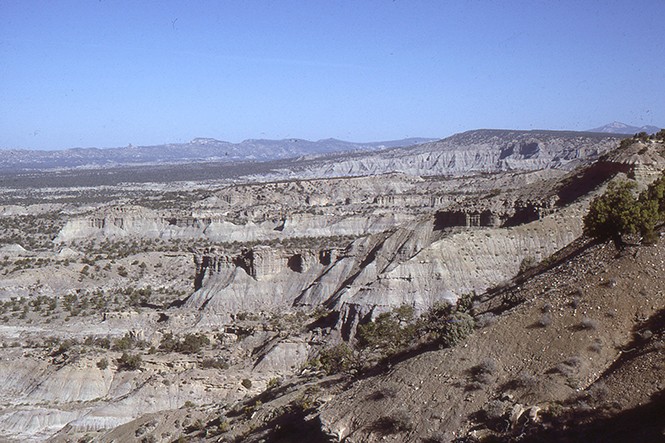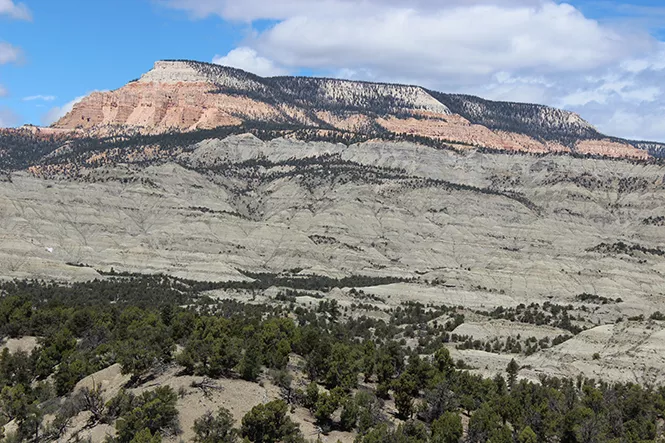
- Daria Bachmann
Conservation groups are ready to challenge potential mining within former boundaries of Grand Staircase-Escalante National Monument after a Canadian mining company announced that it is looking to start extracting minerals in the area.
The revelation that Vancouver-based Glacier Lake Resources had acquired the post producing Colt Mesa copper mine in former Grand Staircase drew the ire of three organizations. Conservation Lands Foundation, Grand Staircase Escalante Partners and Society for Vertebrate Paleontology said in a news release they are "evaluating any and all remedies" to stop the threat of mining in boundaries of the former monument.
Brian Sybert, executive director of Conservation Lands Foundation, says that any mining in the area that was cut from the Grand Staircase would be illegal.
"We believe it would be illegal because Trump's proclamation is illegal and lacks any authority," Sybert says.
Conservation Lands Foundation is among organizations that filed a lawsuit against President Trump's proclamation that cut Grand Staircase by about 900,000 acres.
The lawsuit, currently pending in U.S. District Court for the District of Columbia, argues that the president does not have the power to unprotect scientific resources on public lands that have already been granted protection, and that the president's statement that the same resources can be protected within smaller boundaries is factually incorrect.
Before any land is disturbed in the area that was cut off from the monument, the lawsuit challenging Trump's proclamation should be resolved in court, Sybert says.
Originally at more than 1.9 million acres, Grand Staircase was the largest national monument in the country when it was designated by President Bill Clinton in 1996. On Dec. 4, 2017, Trump signed the executive order that reduced the monument almost in half, angering conservation groups and Native American tribes.
David Polly, the president of Society of Vertebrate Paleontology, says only Congress has the authority to remove special protections from historic, archaeological and scientific resources on public lands.
Under the Antiquities Act of 1906, Congress delegated to presidents the authority to protect special and historically significant areas by conferring national monument status. Polly argued that Congress hasn't given presidents the authority to unprotect national monuments.
In its June 13 announcement, Glacier Lake Resources said it acquired the Colt Mesa property where it intends to mine the Circle Cliffs area east of Boulder for cobalt and copper.
Kimberly Finch, communications director for the Bureau of Land Management's Utah State Office, says that "acquired" isn't a correct term.
Between Feb. 5 and June 19, 2018, four mining groups had recorded claims with the BLM's Utah State Office on public lands recently excluded from the Grand Staircase-Escalante National Monument.
The BLM's Utah State Office has not yet received any notices or operational plans for these claims, Finch says.
"The BLM has not received a mining plan of operations from any entity regarding these mining claims or for the Colt Mesa copper mine to date and the field office has not received a notice from any entity regarding the commencement of exploration. We will process any plans of operation and notices under the current laws and regulations," Finch writes in an email.
Satvir Dhillon, president and executive director of Glacier Lake Resources, said in a news release that surface exploration work will start this summer on the Colt Mesa property and drill permitting will be "initiated shortly."
Dhillon didn't respond to requests for comment.
Paleontology
The area cut off from the monuments supports a delicate desert ecosystem and a landscape enclosed in cliff walls, rich in Triassic era fossil fuel deposits, conservationists say.
In the 1980s and early 1990s, paleontologists Rich Cifelli and Jeff Eaton found fossil-bearing rocks belonging to the Cretaceous geological period that were not represented anywhere else in what later became the monument.
"Because these fossils are tiny, delicate and unique and because they occurred in some of the geological units that were most vulnerable to destruction by mining, they were an important reason that the monument was created. Fossils in other parts of the monument showed the potential of the whole area for science, and they were a key motivator for the creation of the monument in 1996," Polly says.
Many of the early mammal sites discovered by Cifelli and Eaton were cut out of the monument, Polly says. All of the Permian and almost all of the Triassic areas likewise have been stripped of protection. The cuts also include some of the important Cretaceous units. The Cretaceous is the last period of the Mesozoic, ending with the asteroid impact that caused the extinction of the last dinosaurs.
Most of the Cretaceous rocks in the monument make up the fabric of the Kaiparowits Plateau, a roughly triangular 1,650-square-mile landform that extends from the town of Escalante almost to the border with Arizona. Polly says that 13 new dinosaur species have been discovered there, including relatives of the three-horned Triceratops.
Eaton, who is now retired and lives in Tropic, Utah, says that the Kaiparowits Plateau first came under threat in the late 1980s when the Andelex coal mine was proposed in the area.
At the time, he wrote then-Secretary of Interior Bruce Babbitt about protecting the area. In the early 1990s, the Southern Utah Wilderness Alliance asked Eaton to prepare a document for its court case against Andelex. Along with two other curators at the Utah Museum of Natural History, he put together a document emphasizing the unique paleontology, archaeology and natural environments of the plateau.
"It was that document that was incorporated into the proclamation for the Grand Staircase-Escalante National Monument. I had no advance knowledge of the monument being created and was never contacted by the Department of Interior. Also, our document referred specifically to the Kaiparowits Plateau and ultimately the monument included far more than the plateau," Eaton said in an email.
At the time when the monument was created, little was known about dinosaur fossils in the region, Eaton said. With the monument size reduced, he's concerned that vandalism, poaching, or ATVs will pose problems for bone sites such as those containing dinosaurs, turtles and crocodilians.
Although some protections still are in place, conservationists say that they are not as strong as those offered by national-monument status.
The Paleontological Resources Preservation Act of 2009 prohibits collecting all vertebrate fossils on public lands for any reason other than scientific. It requires that vertebrate fossils from federal lands go into a public repository such as a museum where they can be studied and enjoyed by everyone.
Exploitable minerals are often found in the same bedrock units that contain the most important fossils, Polly says. For example, he says coal is a type of fossil made up of plants from ancient swamps. The rare mammal fossils lived on the borders of those swamps so the rock units that bear the vertebrate fossils are sandwiched in the layers that bear the coal. Other examples include uranium, copper and titanium.
Should mining take place in the area that was cut off from Grand Staircase, Polly notes the fossils could be destroyed in sites that have not been excavated and the geological context could be lost in sites that already have.
"Both are important to science because paleontologists and geologists revisit sites time after time to reconfirm original observations and to collect new data, especially previously impossible data that can now be collected because of new technology. Scientists often choose to work inside the boundaries of the monument because the sites will be permanently protected, thus ensuring that the scientific process can continue into the future," Polly says.

- Daria Bachmann
- As many as 13 new dinosaur species have been discovered in the Kaiparowits Plateau.
Watch Continues
Nicole Croft, executive director of Grand Staircase Escalante Partners, says that her organization submitted a letter to the court requesting to be informed of any ground-moving activities within 48 hours of the BLM approving them.
"There technically isn't a route for any company to pursue movement on a claim within the lands excised from the Grand Staircase until a new management plan is approved and in place, so we don't believe anything other than a claim can happen, for the time being, however, we're living in unusual times where the standard rules don't seem to apply, so we are remaining vigilant," Croft says in an email.
Not everyone shares the same concern. Garfield County Commissioner Leland Pollock dismissed conservationists' claims about the dangers of mining as "nonsense," and says that environmental issues would come up in the environmental-impact statement, should any mining proposals move forward.
"I support mining. There are areas that need to be mined and there won't be an environmental effect," Pollock says during a phone interview.
With BLM managing areas that had been cut off from the monument, Pollock says protections are still in place.
Others say the mere staked mining claims demonstrate the danger that mining poses to the area.
"That is a clear and present threat. To say that it is protected is inaccurate," Sybert says.
A mining claim, however, is not an approval to explore or develop a mine. To stake a mining claim, an interested party must record their claim with the local county office and then record their claim with the BLM Utah State Office within 90 days.
"A claimant may undertake exploration activities causing surface disturbance of 5 acres or less, 15 days after they file a notice with the BLM. The proponent must also post a financial guarantee/bond before exploration can begin, which ensures they will reclaim all surface disturbance," Finch says.
Any exploration activities disturbing more than 5 acres, or any actual mining operations require the proponent to submit a plan of operations to the BLM, which initiates an environmental analysis under the National Environmental Policy Act which also includes public involvement, Finch says. Before any operations can begin, the proponent must post a bond to ensure that they will reclaim all surface disturbance.
Still, Polly says, it's "a murky area" whether mining in the area is currently legal.
"The situation not only puts the monuments' fossil, archaeological and other resources at risk, but it puts these companies and their stockholders at risk because they stand to lose their investments if they have been misled into thinking that their claims are legal. Trump's proclamations were not thought through and they are bad for Americans no matter how you look at it. Canadians, too," Polly says.